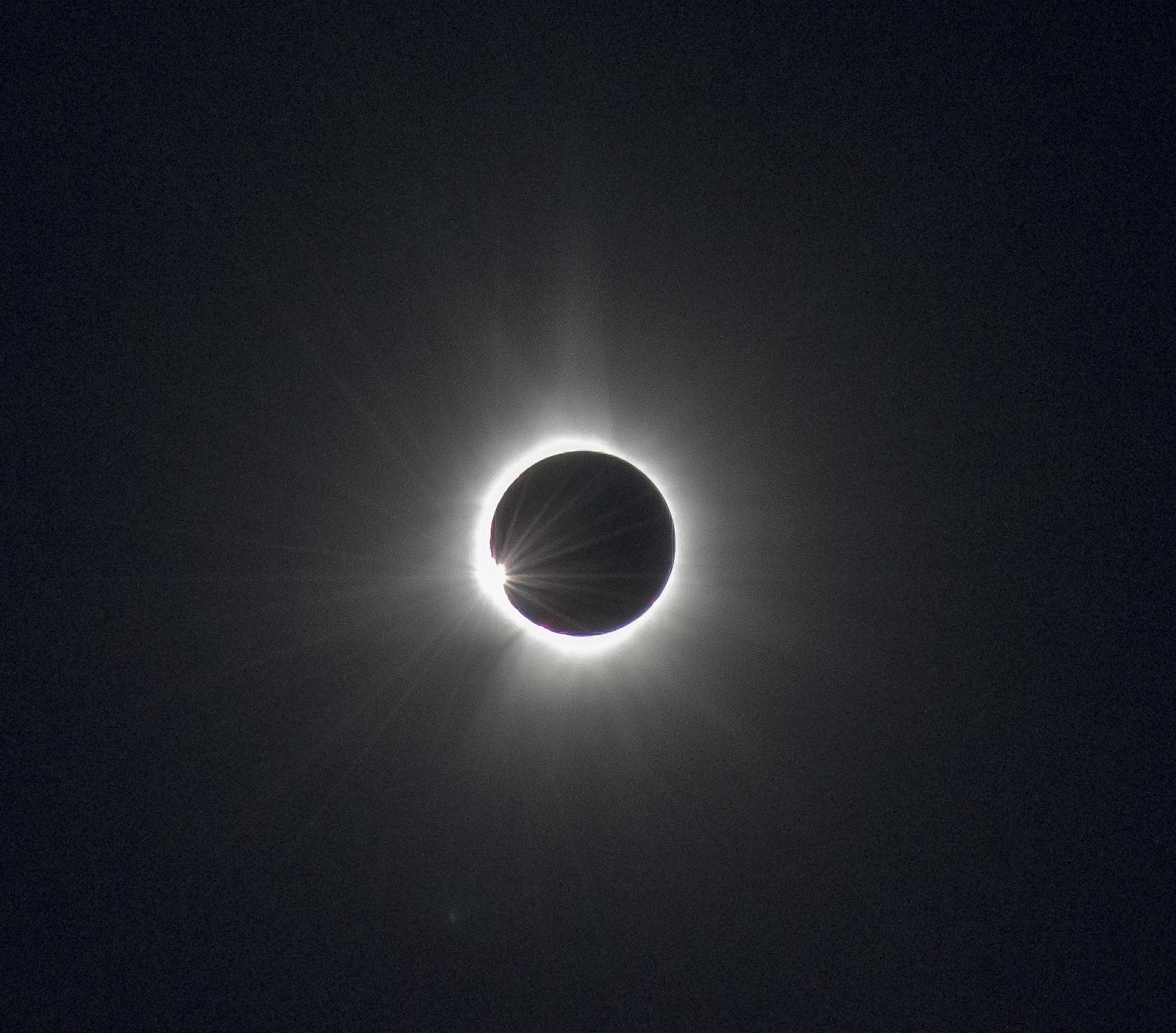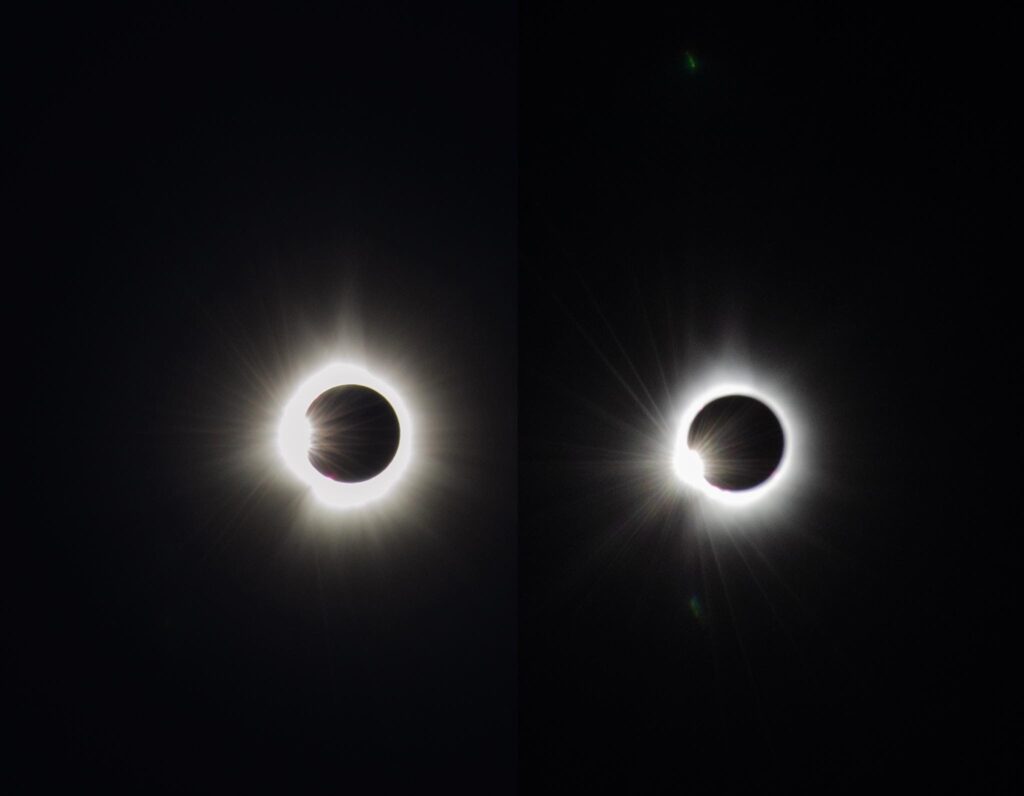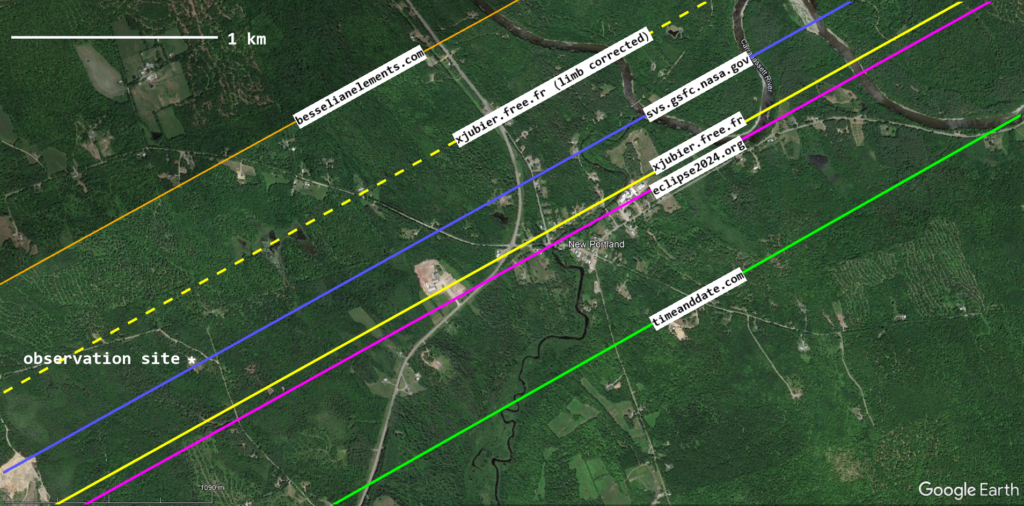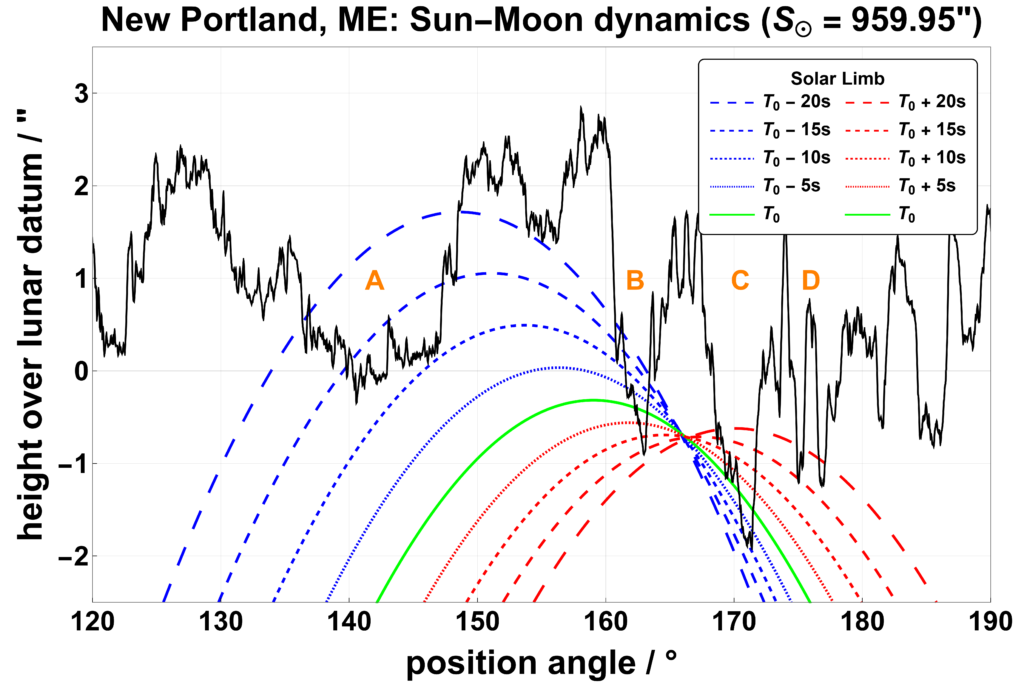A remarkable observation
The following post by Jillian Culver on the Solar Eclipse Chasers Facebook page caught our attention as it describes, rather in detail, an intriguing observation of the 2024 April 8th total solar eclipse from the very edge of the umbral shadow path in Maine:

Several aspects of this description are remarkable. Among them, the mention of getting quite dark for an extended period, sufficiently dark to be able to observe the eclipse without eclipse spectacles, and, very intriguingly, the mention of visibility of Baily’s beads throughout most of, if not all, that period of darkness. Also worth of notice is the fact that the eclipse was observed under stunningly cloudless skies.
We contacted Ms. Culver to get further pieces of information on her observation, and she was very kind to provide us with the coordinates of her observation site and with supplementary details. We are very grateful to her for her kindness and interest.
The first question we asked was about solar corona visibility, to assess what the eclipse looked like during that period of darkness. Here is Ms. Culver’s description:
… the corona was maybe 2-3x [solar radii from the Moon’s edge]. The light of the outer corona extended outward 360° in flamelike shapes and movements. Both the inner and outer corona were visible …
This clearly establishes that the sky had darkened sufficiently for its brightness to become lower than the brightness of the outer corona, making it possible for the fainter parts of the solar atmosphere to become fully visible for an extended period of time. We suspect that from this edge location the visibility of the solar corona was hardly any different than from locations deeper inside the umbral shadow path.
The second question we asked was about the visibility and appearance of Baily’s beads. Here is Ms. Culver’s description:
The Baily’s bead was there for the entire duration of “totality” from what I can remember and also what the photos indicate. There was a diamond ring, and then that diamond ring shrunk to the size of a star. It was almost unnoticeable at one point, if you squinted it may have looked like absolute totality. The bead twinkled like a star, as bright or perhaps a little brighter than the brightest star (or planet) in the sky. It slowly moved downward a few degrees. It was like the Moon slowly rolled over the edge of the Sun.

(credit: Jillian Culver).
This is a most fascinating description of what was visible from that observing location: the simultaneous view of the inner and outer corona and of Baily’s beads for several tens of seconds, as seen in Figure 1. We have no doubts on that being possible: we had an almost identical experience during the 2017 August 21st total solar eclipse from a location ca. 500m inwards from the totality path southern edge, near Vale, Oregon. The only difference is that we clearly had ca. 15s of true totality. Details of that observation can be found in section 3.1 of this article.
It seems plausible that what Ms. Culver experienced was an extended period of “coronality” without a period of “totality”. The difference is subtle, but the two terms indicate slightly different ideas. Totality is the period of complete photospheric extinction when the entirety of the Sun’s photosphere is occulted by the Moon. Coronality is the period when the solar corona is visible, usually both the intense inner and fainter outer corona.
Almost anywhere within the umbral shadow path, totality and coronality almost coincide. From around the centreline, the solar corona only becomes clearly visible just a handful of seconds before second contact and returns to be hidden by the returning brightness of the photosphere a handful of seconds after third contact. By covering the returning photosphere, it might be possible to perceive a faint glow on the opposite side of the Moon for a little while, but that is just a pale shadow of the solar corona during totality. Very close to the edge of the totality path, the two terms can diverge dramatically: there could be no or a very short totality, with coronality lasting for tens of seconds.
Ms. Culver very likely did not experience photospheric extinction, but surely experienced an extended period of coronality, as her description suggests:
The bead and corona together were present for about 35 seconds […]. If you count time with diamond ring transitions it was about 50 seconds. There is 49 seconds between the two diamond rings photos […]. Notice the difference in position of the diamond. This would be the distance the bead travelled over the duration of totality.

Ms. Culver also describes observing shadow bands after coronality:
… we saw shadow bands as well, for maybe 20-30 seconds. I wasn’t counting but it was for a while. If the other transitions lasted longer from our location, maybe this is true too for shadow bands? […] we sure saw, and it was mesmerizing.
Ms. Culver’s experience of the eclipse was for sure very remarkable!
Locating the observing site with respect to eclipse maps
Ms. Culver’s detailed observation supports the idea that her observation site was outside of the totality path, due to the continuous visibility of Baily’s beads, indicating that there was never photospheric extinction.
To investigate this point, we can compare the observing site location with the umbral shadow path southern limit computed by various online sources: in green timeanddate.com, in yellow xjubier.free.com, in magenta eclipse2024.com, in blue svs.gsfc.nasa.gov and in orange besselianelements.com. The yellow dashed line is Xavier Jubier’s southern limit location inferred by looking at where the lunar limb corrected totality duration is 0s.

Because the Baily’s bead(s) had a naked eye detectable size, even when at their minimum size, the observing site needs to be at least some distance outside the limit. Hence, only the orange and the yellow dashed line in Figure 3 seem compatible with the observation.
As Ms. Culver writes in her Facebook post, she initially thought to be inside the totality path, as the online map (we do not know which one) she consulted depicted the eclipse southern limit as bisecting the township of New Portland, so just less than 0.5km south of her chosen observing location. Because some eclipse maps did not account for the lunar topography (and, to a minor extent, for an improved eclipse solar radius), in some extreme case as this one, uncertainty was created for some users. Of course, this does not mean that the observation was a failure. To the contrary!!! What Ms. Culver observed must have been extraordinarily mesmerizing and rather rare, as we know firsthand. Even if most observers’ emphasis during total solar eclipses is on seeing the solar corona for as long as possible, liminal observations like this one can contain as much beauty.
Simulating the Sun-Moon dynamics at the observing site
We can gain a deeper appreciation of Ms. Culver’s observation by simulating the relative motion of the solar and lunar limb as seen from the observing site and comparing it with what was observed.
Figure 4 depicts the result of such simulation (the eclipse solar radius was assumed to be S=959.95″), based on an accurate eclipse computational model by John Irwin. The thin black line represents the jagged lunar limb profile, with its collection of mountains and valleys that are responsible for the formation of Baily’s beads. The other lines portray the position of the solar limb relative to the lunar limb at various times. The reference time T0 = 19h 31m 05s UTC, corresponding to 15h 31m 05s local time, is representative of the time of maximum eclipse (green line).

The reference time is T0 = 19h 31m 05s UTC.
Now that we have a precise simulation, we can interpret it in terms of what it would have generated for the observer. Twenty seconds before T0, the photosphere would have still shone brightly in the wide lunar valley indicated by “A”: the “diamond ring” would have been rather blinding. By T0 – 10s, a sort of darkness would have descended on the observing site, as the only Baily’s bead remaining would have been the one in the lunar valley indicated by “B”. This valley is rather narrow, and it is likely that this Baily’s bead would have been seen as a “star”, unable to illuminate the sky. By this time, I have no doubts that the solar corona would have already appeared in all its glory. For the following 25s, a beautiful dance of two Baily’s beads would have taken place against the backdrop of the inner and outer corona under that temporary darkness. As the Baily’s bead generated by the lunar valley indicated by “B” was very slowly shrinking, the Baily’s beads generated by the lunar valley indicated by “C” was also incredibly slowly becoming brighter and brighter. This second Baily’s beads would have also been seen as a “star”. At T0 + 15s, other Baily’s beads would have appeared, ushering a second “diamond ring”, probably less dazzling than the first one was.
If you go back to Ms. Culver’s description, we can recognise aspects of what the simulation is telling us. We expect the two “diamond rings” to be ca. 30-45 degrees apart, and Figure 2 supports this. Between the two “diamond rings”, there are at least 25s, probably more, of conditions conducive to “darkness” when simultaneously the solar corona is shining and the Baily’s beads evolving. This is compatible with the ca. 35s of darkness estimated by Ms. Culver. The bottom of lunar valleys indicated by “B” and “C” are separated by ca. 8 degrees, which is a short angular distance to separate visually. I think it would have seemed to the naked eye that the Baily’s beads were migrating, as they were one shrinking and the other growing.
We already know that Ms. Culver had an amazing view of the eclipse, but the simulation beautifully shows how detailed and accurate her description of what she saw that day is.
On the appearance of coronality: an enigma
We have so far collected 4 detailed descriptions of the appearance of a total solar eclipse from the edge: one in 2017, one in 2023 and two in 2024. In 2017 the observing location was in Vale (Oregon), ca. 500 inwards from the southern edge (the experience is described in Section 3.1 here), in 2023 the observing location was in Cape Range National Park (Australia) ca. 500 inwards from the northern limit (the experience is described in the fourth article here), in 2024 one observing location was in Stephenville (Texas), ca. 500m inwards from the northern limit and the other was in New Portland (Maine), Ms. Culver’s one, ca. 500m outside of the southern limit. All quoted distances are from the true limb limit computed with an eclipse solar radius S = 959.95″. All these observations were blessed with cloudless skies.
In 2017 we saw a short totality embedded in a longer 40-50s period of coronality, with a simultaneous view of the inner and outer solar corona and of slowly evolving Baily’s beads. We believe that Ms. Culver’s experience in 2024 and our experience in 2017 share many similarities. In 2023, despite definitely having a period of true totality, we saw neither the outer nor the inner corona. Only a very thin rim of shiningly bright light was visible all around the lunar limb. In Stephenville, we could see for an extended period of time, far longer than totality, the inner corona on the opposite side of the contact points, but the outer corona was absent.
What seems rather puzzling is that the appearance of the eclipse can be different for the same eclipse from an observing location ca. 500m outside of the limit and from an observing location ca. 500m inwards from the limit. Also, over three different eclipses observed more or less from the same distance inwards from the true limb limit, the eclipse had each time a very different, but always surprising, appearance: from a full view of the outer corona in 2017, to the very thin ring of light without outer or inner corona in 2023, to an intermediate situation in 2024. Maybe the reality is that the view of an eclipse from so close to the true limb limit, being so liminal in nature, cannot be easily categorised.
The eclipse appearance at the edge of the totality path seems to escape prediction: every time, I was caught by surprise, and invariably utterly stunned by what was on display… May the mystery endure.
